Where to get Japanese craft beers in Singapore
The island’s taps have plenty of options if you know where to look
Craft beer has been an enduring trend in Singapore’s nightlife scene, with more bars opening in recent months, serving everything from American micro IPAs to Belgian lambics to Danish gypsy brews. Among the plethora of options are some great Japanese craft beers, too, and we don’t just mean Sapporo Black and Kirin. We’re talking solid microbrews you’ve never heard of before, and you’ll find them everywhere if you know where to look. Here’s our mini-guide on where to go to explore the exciting world of Japanese craft beer.
The first and most visible go-to spot for Japanese craft beer, 313@somerset’s semi-alfresco bar introduced us to the pleasures not just of Sapporo Black but, more importantly, of the now ubiquitous Kiuchi Brewery Hitachino Nest offerings, from seasonal brews to classics like the white ale and the lager, all of which are available on tap here. Their bottled selection is even bigger, and on top of that, regulars should look out for their seasonal and limited-edition offerings from other breweries in Japan, too. Need more reason to go? They’re open for lunch and serve affordable sets, yakitori and other beer essentials.
New York’s Burger Joint came to Singapore last year, in a tucked-away back alley of Amoy Street, offering an affordable, wood-paneled, diner-like respite from the fancy fray with its basic but delicious burgers, and a whopping 18 craft beers on tap, covering the UK, the US, Japan and other countries. The selection changes often, but on most nights you can count on a brew or two from Japan. Recently they’ve been regularly tapping stuff by Yamanouchi brewery Tamamura Honten’s Shiga Kogen beers.
After years of pleasing us with their 313@somerset location, the people behind JiBiru have opened a new bar, in fancier surroundings, but with the same focus on Japanese craft beer. Craft Beer Bar Takumi at the Mandarin Orchard Hotel has many JiBiru staples on its menu including Hitachino Nest White Ale, Shiga Kogen Pale Ale and Owa. Adding to that, they have a focus on limited edition and barrel-aged beers like Kuro Owa Grand Cru 2013 aged in Bordeaux wine barrels, Shiga Kogen No 10 Anniversary IPA and Belgian offering Buffalo Grand Cru Barrel Aged.

One of our favorite new craft beer bars, this friendly and super casual spot on the second floor of an Amoy-area shop house is always packed with a friendly crowd, thanks to its even friendlier staff, a great selection of microbrews on their 18 rotating taps from around the world, regular and exciting single-brewery tap takeovers and Asian-inspired pub grub like bacon tempura and cereal frog legs. The taps often feature Japanese brews, and a recent tap takeover featured beers by Shiga Kogen.
Located below Anthony Zhong's (ex-Jigger & Pony) Shin Gi Tai, this cozy beerhouse sports a rustic and vintage outlook to create a super laidback vibe for all to enjoy. Besides the obvious craft beers that'll be in stock, they'll also be serving a menu of dim sum to go along with your drinks. Drinks wise, they offer over 50 different kinds of apple ciders, bottled craft beers and other alcoholic beverages. Local craft brewers like Innocence brewery and Crossroads have their craft beers pouring permanently. On the Japanese beer front, there are some regulars on the bottled and canned beers menu, such as the Suiyoubi No Neko, a witbier from Yo-Ho Brewing Company in Nagano, as well as their American-style IPA Aooni, both in cans. They also carry bottles of Nagoya Akamiso Lager, which you’ll be hard-pressed to find elsewhere.
Pioneering the whole craft-beers-in-hawker-centers trend, Good Beer Company follow-up Smith Street Taps has a loyal following. It’s basically your usual kopitiam stall setup with no frills—though plenty of delicious and cheap food nearby. You purchase your beer on the spot and sit at the ubiquitous plastic tables that surround the stall. Fans stay tuned to the bar’s Facebook page to see what’s new on tap: regular appearances by Sapporo Black and Hitachino Nest aside, they have recently carried a couple brews from Iwate prefecture’s award-winning brewery Sekinoichi Shuzo, which does Iwate Kura beers.
Like what you see? For regular updates on Japanese food and drink in Singapore, follow Bite! Japan on Facebook.
Like what you see? For regular updates on Japanese food and drink in Singapore, follow Bite! Japan on Facebook.
Advertisement
Another February, another Valentine’s Day dinner to plan. If you’re over the usual options in Singapore, try something Japanese for a change. And we don’t just mean a bowl of ramen (although that, now that we think of it, would make for some nice alt-romance). Singapore’s top Japanese restaurants are pulling out all the stops for their gorgeous V-Day menus. These are a few of the most exciting.
Easily one of the most atmospheric places on this list, this long, narrow and elegantly lit Tiong Bahru stalwart is great both for sushi (best enjoyed at the bar with the talented, new chef Chong Yoong Kiong) and casual but stylish Japanese and Japanese-fusion dining. Through the end of February, they're serving a six-course couple menu ($188) that brings the best of both: oyster with yuzu pepper sauce, grilled halibut with miso, assorted sushi and sashimi and other goodies. The price includes a bottle of sake.
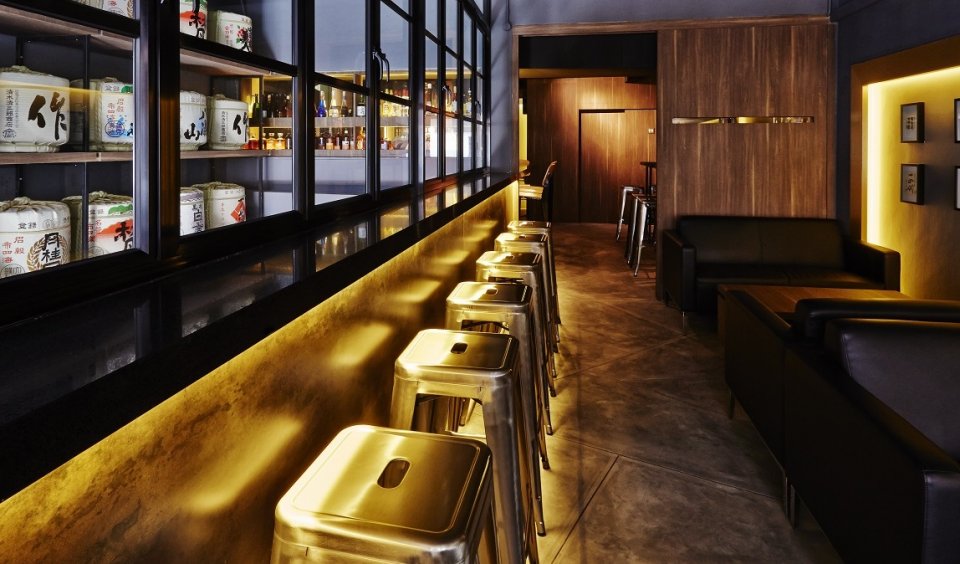
There aren’t too many Spanish-inspired Japanese restaurants in Singapore, and when you couple that with Boruto’s high-ceilinged, warmly lit interiors, you have a classic date night with an industrial edge on your hands. Chef Angus Chow’s Valentine’s Day menu is $188 per couple and comes with a bottle of wine, and the dishes—portioned to share—include intriguing options like beef tataki, made with A3 wagyu from Saga, foie gras a la plancha with shiitake jam; and black truffle somen with sakura ebi and caviar.

If you are in a new romance this V-Day and prefer to keep things fun and casual—preferably with a pretty waterfront view, Japanese fusion bar and restaurant Kinki is a great choice. Also famous for its regular DJ gigs, the Valentine’s package here is similarly fun and simple. On Feb 14, couplies spending $150 or more stand a chance to win a staycation, discount vouchers from The Fullerton and food vouchers for your next visit to Kinki. And if you’re currently unattached, come by on Feb 11 for a singles’ party, with games and Cupid’s Kisses (six shots) for $50.

One of 2016’s most talked-about openings, this tunnel-like, industrial-chic French-Japanese is located on Gemmill Lane and feels like dining inside a bunker—a very well-decorated bunker, that is. The specialty here, as the name might suggest, is charcoal-grilled food, though the three-course V-Day menu ($199 per couple, with two glasses of rose) has plenty of other kinds of dishes, like the Crack Me Up amuse-bouche with rice paper and ebi, and the Garden of Love main, a salad of spanner crab, orange-fennel and pomegranate dressing. The set menu is available Feb 10-14.

Fort Canning Hill’s ultra-pretty colonial white bungalow is the perfect choice for some good, old fashioned romance—so much so that it’s actually a popular spot for weddings and receptions, too! Chef Keisuke Matsumoto brings his delicate French-Japanese sensibility to the luxurious, five-course menu ($388 per couple). Dishes like the sautéed scallops with pomme ecrase, the Kagoshima wagyu steak and the amadai fish—not to mention the Pol Roger Champagne included in the set—are sure to make a memorable evening.
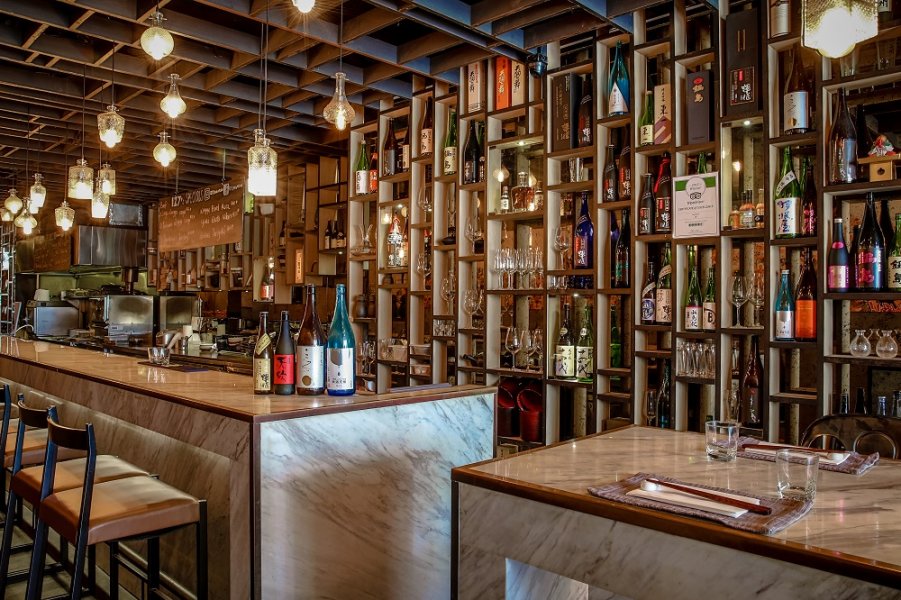
If you are a rock star couple that eschews traditional romance, check out what’s in store for club-like Japanese-American izakaya Izy. Cozy up knee-to-knee at the dimly lit bar, and snap a few selfies with the colorful mural behind you. Foodwise, there’s a $230 menu for two, which includes poke bowls, sashimi in Japanese tofu skin and rice bowls topped with uni, ikura and negitoro. For an extra $30 per person, you can pair your meal with three cocktails each—courtesy of secret bar Cache in the back. Learn more about Izy here.

Trained on high-quality New Zealand beef in the teppanyaki restaurants of Christchurch, chef Nick Tan at Boat Quay's Wakanui will ensure you're in good hands for your carnivorous V-Day date. The cozy restaurant is serving a four-course set menu, with main options including 21 day-aged NZ Ocean beef ribeye and NZ spring lamb chop, both cooked over a binchotan grill. Save room for the signature Anna Pavlova, Chef Tan's take on a classic New Zealand dessert.

If the relationship is too young for sweeping skyline views and multi-course fine dining, Sen of Japan is a great choice for a low-stakes but memorable date. It's very pretty, with a ground-level view of the bay, and has a contemporary Japanese menu designed by Nakano Hiromi who used to head Las Vegas' legendary NOBU. They're skipping the set menu for V-Day, so you can order their signatures like the A5 Tochigi wagyu steak and the black cod soy. But if the mood feels romantic, they have a couple of special dishes: the heart-shaped baked salmon with tartar sauce, and the pink sashimi maki, both available Feb 10-14.
Like what you see? For regular updates on Japanese food and drink in Singapore, follow Bite! Japan on Facebook.
Advertisement
In case you’ve been living under the rock for the past couple years, Suntec is home to more than just your favorite Lush store and the exciting new PasarBella. On the seventh floor is one of Singapore’s most beloved Japanese food enclave (and there are a lot of those lately). If you haven’t been already, here’s a guide to what you will find there.
Brought to you by the same people as Tendon Kohaku, which also has a branch at Eat at Seven, Agedoki is a pretty little place, all wooden booths, red banners and lots of natural light, making it easy to forget you are in a mall. They use good ingredients, including Nagano pork, Hokkaido Nanatsuboshi rice and lots of homemade sauces, including the demiglace. Don’t miss the shrimp-wrapped katsu.

Drop by this high-ceilinged, expansive izakaya for drink-friendly eats like Jya Jya Men, cold noodles with minced meat sauce, and the restaurant’s signature Katsuo Warayaki, a slab of smoky thick cut tuna served in a foil packet. There are also sweets like mochi ice-cream and cold Coedo draft beers to round out your meal. Dine in a relaxed black and slate gray space with good city views.
Agedoki’s sister restaurant is equally adept at deep-frying, specializing in tempura donburi, or tendon. Choose from a short list of options (regular, spicy, vegetarian, et cetera), each of which includes a generous bowl of Nanatsuboshi rice and an assortment of tempura, such as crab stick, chicken, shrimp and veggies. The secret is in the sauce.
Nigiro Cafe is a Tokyo-based cafe that fuses Japanese flavors with Italian and French cooking. While the fusion cuisine has been done before, the chef behind the concept, Kensuke Sakai, has the distinction of being the youngest Japanese Iron Chef competitor. He's been touted as the creator of the best Caesar salad in Tokyo—a dish that includes grilled shrimp and generously sliced Parmesan—as well as eggs benedict and deux fromage cake.

Nikunohi is a beef-focused restaurant from Tokyo. The Singapore outlet is their first and only overseas branch. Helmed by Kensuke Sakai (yes, the very same as Nigiro), the restaurant offers yakiniku meats like beef tongue Iberico pork shoulder and beef ribs. Round out your meal with small plates such as wagyu sashimi and wagyu beef curry rice.
Most recently famous (again) for their sister outlet, Kuro Maguro at Tanjong Pagar Centre, Eat at Seven’s Maguro-Donya Miura-Misaki-Kou Sushi & Dining specializes in fresh sashimi, especially maguro tuna, salmon, swordfish and yellowtail from the Misura Misaki harbor. They've got restaurants in Yokohama, Tokyo and Kanagawa, but this is the Japanese chain's original foray overseas—with dishes of grilled magura kama and a trio of hon maguro sashimi.

The fifth restaurant to open here is Tokyo's chicken ramen chain, Menya Takeichi, which has 40 stores across Japan. Tuck into the Tokyo ramen chain's signature dish, the chicken Paitan ramen, which features a creamy chicken and collagen-infused broth. And while it's the hot favorite here, diners can also choose to have the clear soup alternative, made from bonito flakes for an umami flavor. Hearty sides include the grilled prawn with anchovy creamy sauce and the gyoza.
Sundubu, a type of Korean stew with tofu and an assortment of ingredients like chicken, beef and clams, may not be a Japanese dish, but it has quite a following in Japan. With 35 outlets across the country, Tokyo Sundubu makes its debut here at Suntec City, offering diners over 23 collagen-infused variations. The restaurant is known for its premium, handmade tofu and the savory-spicy broth boiled with tategi, a red pepper condiment.
Like what you see? For regular updates on Japanese food and drink in Singapore, follow Bite! Japan on Facebook.
Advertisement
Singapore is awash in ramen options, and the trend is showing no signs of slowing down. If you’re suffering from ramen fatigue, or just want to know how to discern the difference between what’s great and what’s less great, fear not. We’ve spoken to Singapore’s top ramen chefs for their input.
Who better to ask about the nuances between good and great ramen than Yota Shiiba, the deputy general manager of probably Singapore’s most beloved ramen chain, Ippudo. Shiiba reminds us that despite its apparent simplicity, ramen is actually a very complicated dish. “Ramen involves stock, broth, noodles and toppings, and a great bowl of ramen achieves a good balance among all the components.”

Spicy Chilli Boss Rib Ramen at Buta Ramen
Ippudo has been in the news lately in Singapore, for the launch of Kuro-Obi, a sister concept previously only in New York City, specializing in a chicken-based broth. When asked what is so great about the signature broth, Shiida says it is the emulsification. “Similar to salad dressing, a perfect chicken broth needs to ensure both chicken soup and chicken oil are well-mixed,” he explains. “If salad dressing cannot be mixed well, the oil will be separated from others.”
It doesn’t matter how good the noodles are, or whether you like them springy or soft. If they sit in the bowl, too, long, a great bowl of ramen runs the risk of becoming just so-so. This seems to be a problem in Singapore, says chef Sandy Yeo of Buta Ramen, a CBD gem famous for its unusual additions and creative takes on ramen. “Many Singaporeans like to put their noodles in their soup spoon and then into their mouth, but by then it becomes soggy. It’s totally different from how the Japanese eat it, which is to slurp it directly from the bowl.”

Chef Sandy Yeo of Buta Ramen
Ramen chefs can debate endlessly about the finer components of technique: the ingredients of the stock, whether to simmer or boil, et cetera. But sometimes the best ramen involves an entirely unexpected technique. Asked about the most unforgettable ramen of his life, Yeo remembers a bowl at Kyoto’s famous Gogyo Ramen. The secret is the “burned broth” which is cooked in a wok after pork lard is heated to the point of flames, about 300C. “It’s an umami bomb. It hits you hard.”
Like what you see? For regular updates on Japanese food and drink in Singapore, follow Bite! Japan on Facebook.
Advertisement
Excellent sushi isn’t hard to find in Singapore, especially when you are willing to pay for it. But what is it about sushi that makes it truly great—other than its freshness of course? We asked two of Singapore’s leading sushi masters about the types of factors they consider when making sushi. Here’s what they said.

Aged tuna sushi at Ashino
Chef Ashino, sushi master at the eponymous restaurant at Chijmes, strongly believes that in preparing sushi, a sushi master must pay respect to the life of the fish by preparing it in a way that best showcases its natural flavors. This is why sushi fish can be prepared in many different ways, not just served raw. Over at luxe CBD sushi restaurant Sushi Mieda, for example, the seafood can be sprinkled with salt, soaked in vinegar, marinated with konbu seaweed, simmered in a flavoured broth, steamed or slightly aged.

Chef Keisuke Ohno of Sushi Mieda
There’s more to sushi than just freshness and expert slicing. The perfect piece also comes down to the perfect temperature. Too cold and you won’t get to enjoy the fattiness of your otoro; too warm and your beautiful sea eel will taste limp. Ashino tells us that it all boils down to “making the fish and the rice close in temperature.” Sushi Mieda’s Keisuke Ohno says the rice should be eaten hitohada—that is, at skin temperature.
While most sushi restaurants boast about the freshness of their fish, there’s no one better in Singapore than Ashino to tell us about the importance of aging seafood a couple days. After all, his restaurant specializes in the procedure. “Aging is a new technique whose purpose is to maximize the umami of the meat,” he explains. “It softens the sinews and makes it combine better with the rice.”
One of the great pleasures of grabbing a seat at the sushi counter is to watch the graceful sushi pressing sequence by the chef—everyone’s is a little bit difference. But the idea here isn’t to pack the rice and fish as tight as possible. “Don’t touch the fish and rice too much,” Ashino reminds us. “Just shape it beautifully—not too hard, not too soft, just enough to spread nicely in the mouth.”

Sushi Moriawase at Sushi Mieda
You won’t find little dishes of soy sauce at the luxurious Sushi Mieda. That’s because sushi master Keisuke Ohno believes each piece of sushi should be eaten as is. At his restaurant, he is careful give each piece of fish a light spread of nikiri—soy sauce evaporated with sake—for the perfect amount of savoriness. Flavors also come from additions such as spring onion, seaweed and the process of aburi—if you opt for the latter, be sure to experience the pleasures of a charcoal aburi, even though the gas torch is all too common.
When you opt for an omakase, your sushi master knows that even the best prepared sushi can be ruined when eaten in the wrong order. “When you eat something very strong or sweet right at the beginning,” explains Ohno, “your palate becomes fuzzy.” Start with the simple, relatively bland flavors of white fish, moving onto stronger-tasting fish such as toro. In between, be sure to refresh your palate with a vinegary preparation such as kohada or something sweet, such as the Japanese tiger prawn. Finally, finish out with maki mono, tamago yaki and finally, the soup.
Advertisement
Six months ago, we saw the arrival of the first-ever Singapore edition of the revered Michelin guide. Unsurprisingly, of the nearly 30 restaurants that were awarded stars, seven were Japanese. It’s no secret that Singapore has some of the best Japanese food there is, but these are the ones really worth braving the long waits and the empty wallets for.
Japanese chef de cuisine Kenji Yamanaka is at the helm of this beautiful, hushed, one Michelin-starred eatery. The red draped, 24-seater space has a French-leaning seasonal menu with premium Japanese ingredients featured prominently—the rate Ozaki wagyu, blue lobster and the like. Set lunches start at an affordable $68 for a four-course meal, though the all-out eight-course $268 dinner degustation is really something else. Wine, sake and tea pairings are available, too, naturally.
Japanese omakase restaurant Shoukouwa at One Fullerton, the latest venture by the Saint Pierre group, aims to create an authentic Japanese fine dining experience with modern, minimalist interiors and a meditative ambience—and has won not one but two Michelin stars in the process. It's an intimate operation as the main sushi bar seats only eight, and the private dining room allows for a small party of six. Its seasonal degustation menus start from $180 for set lunches and run till $480 for dinner. There is also the option of pairing your meal with a premium selection of Japanese sake, including Junmai Daiginjo from top sake breweries Sawaya Matsumoto, Hakurakusei and Masuizumi.
The eponymous chef's famous Ginza sushi restaurant has not one but two branches in Singapore, one at the Raffles Hotel and the other at The St Regis Singapore. But fear not—both have one Michelin star apiece. It's a serious place for serious lovers of Japanese seafood and culinary craftsmanship. Book a spot to sit around chef Kikuchi Shunsuke at the black-and-beige, minimalist sushi counter at the St Regis (there's a pebbled path leading you in) and be dazzled by the omakase selection. Don't forget to save some time for the dedicated sake bar in the next room.
Ginza’s Michelin-starred Sushi Ichi is no less decorated right here in Singapore. Their beautiful and zen white-and-beige space at the Singapore Marriott Tang Plaza Hotel is all about the sushi, and offers several sets at varying price points ($100-430) for both lunch and dinner. They fly their seafood from Tsukiji a whopping five times a week. The restaurant is adjoined with Kouchi prefecture’s respected sake producers Suigei Shuzo, where you can sample top-shelf stuff as well as more affordable food options, such as the lunch chirashi bowl starting at $33.
Tokyo native Seita Nakahara runs this exquisite enterprise in a Tras Street shop house that recently turned one with a Michelin star under its belt. The place offers the chef’s brand of Tokyo-Italian cuisine, crafted from ingredients sourced from Japan’s diverse regions. Dig in to his ever popular omakase menus ($128, $168, $208) and watch out for the lauded Acqua Pazza, a seafood broth with seasonal fish, clams, dried tomatoes and olives (which he dries in his own kitchen). The other must-try is the uni bruschetta is also a top pick. The rich creamy seafood provides great contrast to the crisp toast.
Topnotch, personalized service makes the hefty $450 price tag for this 10course degustation menu worth the splurge. Expect a sublime European/Japanese feast with exquisite creations using premium ingredients, such as grade nine wagyu and Hokkaido uni, in an understated, elegant space. Hold your breath for signatures like the botan shrimp with sea urchin and caviar, and the wagyu with wasabi and citrus soy. There are over 100 options for premium sake, including two developed specifically for the restaurant.
Advertisement
Singapore’s love affair with Japanese food is hardly new, and neither is our insatiable appetite for tonkatsu—what’s not to love about panko-battered, deep-fried pork cutlets? What’s hot these, however, is the trend of high-end tonkatsu, not the cheap stuff, but premium meats prepared with precision and a focus on good ingredients. With the arrival of Japan Town and other Japanese food enclaves, we’re seeing more and more tonkatsu specialists.
So what’s so great about what they do? Well, in simple terms, tonkatsu—which incidentally was invented in the last 1800s, when many Westerners were coming to Japan under the Meiji era—is a pork cutlet deep fried in flour, egg and panko breadcrumbs. It comes with a Worchestershire-like tonkatsu sauce and a dollop of Japanese mustard (karashi). Most are either hire-kastu, made from fatty pork loin, and rosu-katsu, a leaner fillet. You can have it on its own with miso and cabbage, with Japanese curry and rice (katsu curry), katsudon (served with egg over a bowl of rice), with cheese and even in a sandwich.
But that’s just the tip of the iceberg. The excellence lies in the details. Most places will opt for regular panko in flour form due to its long shelf life. Nama, or fresh, panko is much more difficult to prepare and has to be used that same day but it does give tonkatsu a softer yet crispier texture. Tonkatsu using nama panko remains crisp and airy for up to 15 minutes after it is cooked. Nama panko uses real bread instead of flour and as a result preparation is a long process of steaming then crumbling the bread, before it is dried and cooled. With fresh panko, the bread doesn’t absorb the oil. Good tonkatsu must not be oily and has to remain crispy for quite some time after it is cooked. The texture must not be too crispy and the panko should be airy enough for the sauce to be fully absorbed.
Think you know great tonkatsu now? Try out your palate at some of these contenders.

Tonkatsu Ma Maison
Ginza Anzu
#04-48 Wisma Atria, 435 Orchard Rd., 6262-3408. Open Mon-Fri 11:30am-11pm, Sat-Sun 11am-11pm
Japan Food Town is home to the Singapore outpost of this famous Ginza stalwart, and has the same wood-paneled walls and excellent, premium meat cutlets.
Hajime Tonkatsu
#02-07/8/9 myVillage @ Serangoon Garden, 1 Maju Ave. Open Mon-Fri 11:30am-3pm, 6-10pm; Sat-Sun 11:30am-3pm, 5-10pm
Friendly community mall in the north, myVillage recently got a tonkatsu specialist, chef Tan-San, who has been making the dish since 1993.
Imakatsu
#01-17 The Star Vista, 1 Vista Exchange Green, 6694-6148. Open daily 11:30am-3pm, 5:30-10:30pm
First launched in Roppongi, Japan, where it has a Michelin Bib Gourmand, this katsu specialist at Star Vista uses only Kagoshima pork.
Saboten
#03-10 Itadakimasu by Pacro, 100AM, 110 Tras St. Open daily 11am-10pm
This tonkatsu chain’s latest outlet is at the brand new Japanese food enclave, Itadakimasu by Parco, at 100AM on Tanjong Pagar. Also check them out at 313@somerset and Millenia Walk.
Tonkichi
#07-06 Orchard Central, 181 Orchard Rd., 6238-7976. Open daily 11am-3pm, 6-11pm
Enjoy affordable tonkatsu in the heart of Orchard at this Pokka chain. Get the Kurobuta option, where you can choose either the shoulder cut or the fillet.
Tonkatsu Ma Maison
#02-35/36 Mandarin Gallery, 333A Orchard Rd., 6733-4541, . Open Mon-Fri 11am-3pm, 5-10pm; Sat-Sun 11am-10pm
Easily one of the higher end tonkatsu specialists in town, the cutlets here are as good as you might expect. For a hearty meal, opt for the balanced and delicious katsu curry.
Advertisement
As much as Singaporeans are obsessed with Japanese food, it merits mention that Japanese alcohol is right up there too. And we don’t just mean sake—although Singapore is certainly developing a taste for the good stuff. We also mean all those award-winning whiskies that are sweeping up blind tastings in recent years, and of course, craft beers. Here’s where to try it all in Singapore

It might be an oldie, but it’s a goodie. This place stocks well over 1,000 Scotch whiskies on its lofty shelves covering every distillery in Scotland from affordable drops to truly astonishing bottles like the Mortlach 70-year-old, but the hidden gem here is its Japanese whisky offerings. They have a selection of over 250 Japanese whiskies, ranging from well-known names like the Yamazaki, to lesser known but equally enticing distilleries like the Karuizawa, Shinshu Mars and Akashi.

Sample the unusual pairing of sake and Spanish tapas at this gastro bar. This casual Spanish-Japanese eatery by Chef Pepe Moncayo has close to 100 sake labels in the glass-paned cellar and of course, a sake sommelier on hand. On offer are premium sake offerings from renowned distilleries like Juyondai, Nabeshima and Isojiman. Besides small plates, the restaurant also offers omakase and set lunches (from $38), with items such as cold capellini with tobiko and bamboo clam; and Spanish pork with organic mushrooms and ginger rice.

Located right across Ippudo Ramen, 12-seater sake gastrobar offshoot of the famous noodle chain carries around 70 bottles of sake from over 20 sake breweries all over Japan, and the space doubles as a bottle shop, too. Pair each sake with otsumami, or bar bites like oden ($2 per ingredient), a yong tau foo-like dish comprising items like a boiled egg, daikon, fishcakes and konjac jelly; crispy corn ($6) and beef tataki ($6). Don’t worry, there’s still their Hakata-style ramen available, too.

Helmed by Ginza celeb bartender Daiki Kanetaka, this bar at Bukit Pasoh does interesting Japanese-inspired cocktails alongside its impressive array of Armagnac, calvados and imported blends of Japanese whisky and cherry brandy. There’s not much food at this 28-seater space, but who needs bar bites when you're in good company? It’s not cheap, but with Kanetaka’s elegant, theatrical antics and impeccable attire, the entertainment value is pretty priceless—not to mention the drinks are good.

Perched over the hustle and bustle of Orchard Road is the massive but cozy restaurant Kuvo and its attached bar Elixir. The space, outfitted with lots of dark wooden shelves and a long lit bar, is helmed by Japanese bartender Yutaka Nakashima who shakes up Japanese inspired cocktails. For whisky, they have single and double malt offerings from Yamazaki, Yoichi, Miyagikyo and cult favorites like the Hibiki and Taketsuru. They also offer a glossary of mood words to help you pick your very own bespoke cocktail.

This underground bar at the Forum on Orchard is known for its bustling and dimly lit, chic atmosphere and for its Japanese-style drinks. Whether it's using sake or other Japanese ingredients, the concoctions here are inventive and really pop against the muted backdrop. Splashes of color come from the origami-like cascades by the wall, and you can order food from Uma Uma Ramen upstairs to fulfill that midnight craving.

There’s more to Japanese drinking than fancy whisky and bottles of sake. The Japanese craft beer trend has been going steady in Singapore for a while, and one of the only dedicated Japanese craft beer bars in Singapore, Jibiru is pretty well-trafficked as it's located in 313@somerset. Nonetheless, it loses none of its charm with heavy wooden tables and a breezy alfresco atmosphere. Here, you'll find beers like the well-known Hitachino, as well as an interesting Minoh Cabernet made with grapes. FYI, they also just opened the more upscale Craft Beer Bar Takumi.

A relative newcomer is the bar attachment to Japanese kaiseki restaurant Ki-sho at Scotts 29 lifestyle enclave—and it’s perfect for fans of sake. Dim lighting, a cozy wooden top bar and plush leather seats add to the sexiness of this bar. A must-try is Kakure's house sake, the Tatenokawa Junmai Daiginjo, Nakadori Ki-sho label ($60) which features a delicate aromatic brew with a fruity after taste. If you prefer something that’s more soft and crisp, try the Kinshi Masamune, Matsuya Kyuubei Junmai Daiginjo label ($80) with a clean, fresh aftertaste that goes easy on the palate.

Specializing in sake, shochu and all things Japanese and boozy, this Singaporean offshoot of the well-known Japanese liquor store is a place to discover a still relatively underappreciated drink. Their dark and non-descript location in the Robertson Quay area belies its immense popularity with Japanese and non-Japanese alike. The diffident store manager Naoki Satoh is a wealth of knowledge, whether you’re drinking in (with their excellent drinking snacks) or buying bottles to take home.
This sleek, narrow space on Upper Circular Road is a mix of modern and traditional. Near the entrance is a well-lit cellar made of white onyx, and inside is a Japanese cedar bar counter. On the menu are top notch drinks: a well curated selection of mostly Old World wines (from $20/glass; $68/bottle) and an exhaustive list of whiskies, with options like Yamazakura blended shot ($20) as well as blowout bottles such as Karuizawa Samurai Cask 1984 ($11,250). The bar bites—including duck rillettes ($12) and cheese ($6 per 25g)—are a great complement to the swish sips, and owner and sommelier Daisuke Kawai is a gem.
Like what you see? For regular updates on Japanese food and drink in Singapore, follow Bite! Japan on Facebook.
Advertisement
A cornerstone of Japanese cuisine is amazing ingredients, and there is no better way to enjoy Japan’s best meaty offerings than by grilling them up simply at the table and enjoying them will little more than a few dipping sauces. Here are Singapore’s best yakiniku restaurants, where you can do just that.
For a solid mid-week DIY Japanese grilling experience without the frills, look no further than this reputed casual joint that usually draws the Japanese expat crowd. Each table comes equipped with a charcoal grill—opt for an outside table if you’re worried about smoke in your hair—and the menu offers a lengthy list of various cuts like skirt, short rib and tenderloin. The house sauces that come with are really half the fun.

It doesn’t get more glitzy than this spot at the fancy Mandarin Gallery, which specializes in chilled, not frozen, Japanese black wagyu, offering cuts like flank steak, skirt steak and short rib. On the non-beef front, there is Kurobuta pork jowl and pork belly. To be clear, though, with a location this central and a decor this refined, you can expect the meal to be a splurge.

Not only does this Osaka chain specialize in yakiniku, it also serves gyu nabe, or hearty beef hot pot. Inside the 50-seater, booth seats make for cozy dining around the grill, while customized ventilation hoods make sure diners don’t walk out smelling like grilled meat. While decor is sparse, there is an arresting feature mural of the iconic Mount Fuji. Yakiniku fans should get the Kinoshita Special BBQ set, with several cuts of Hokkaido beef.

Duxton Hill frequently sees new Japanese additions, but this one is worth taking note of. The standout feature at this modern 28-seater is their use of crystal grilling plates instead of the usual metal grills. These plates, specially imported from Japan, retain heat very well so only a low heat is needed to grill the meats. This helps retain the meats juices and produces no smoke. This dinner-only yakiniku joint imports its high quality beef from Kagoshima and Kumamoto. Their non-cooked beef, like the wagyu tartare and wagyu sashimi are also great.
This huge yakiniku chain may have over 600 outlets in Japan and four in Singapore alone, but you would never guess it from the cozy, dimly lit and modern atmosphere of their renovated branch at Chijmes. Their big thing is Kagoshima wagyu, and the Kurobuta pork selection is good, too. You even have the option of grilling up a Chateaubriand with little more than truffle salt.

Not only is this yakiniku spot well-located in bustling Vivocity, it’s also right next door to its sister venue, Shabuya Shochu Bar, making it a great spot for meaty dinner followed by casual drinks. And with their high-performance exhaust system over each table, you can head on over to your next party without worrying about smoke in your hair. Highlights of the meat-centric menu include Japanese Miyazaki beef and Kurobuta pork, both highly prized for the premium quality.

Tenkaichi is so confident about the affordability and quality of its produce that it offers a “best price guarantee”, promising to beat any restaurant with a cheaper price by a further 10 per cent. What’s more, there’s a view of the Marina Bay waterfront. On the menu are a variety of premium and more affordable cuts, but the highlight has got to be the wagyu tokujo karubi, a grade A5 finely marbled black cattle wagyu from Miyazaki prefecture.

Since the first store in Ayase, Tokyo, Heijoen has expanded over nearly half a century to 30 outlets all over Japan. Its glorious debut in Singapore is at none other than the buzzing Japan Food Town at Wisma Atria, sporting a modern, clean-lined woodwork interior, with soft lighting. The highlight of the menu has to be the deluxe cuts of A5 Wagyu Beef directly imported from Kagoshima, but don’t be surprised to also find some Korean staples like kimchi, namul, or bibimbap on the menu.
Robertson Quay may have tons of Japanese places but this BBQ joint specializes in Yazawa wagyu beef from Japan. It does come at a pretty penny with cuts like a chuck-eye Zabuton costing over $60 per serving. The place also has other beef options like kalbi, Kurobuta pork and some chicken in spicy miso, too.

This sleek and minimalize space specializes in omakase-style barbecue including dishes like niku somen (raw wagyu sliced into thin “noodles” and topped with dashi stock, grated yam and seaweed) and yaki suki (sliced wagyu with sweet sukiyaki sauce and raw egg). Each course menu comes with rich cuts like chuck eye and sirloin, plus more adventurous cuts like beef tongue—all from Miyazaki, Kagoshima and Iwate prefectures.
Like what you see? For regular updates on Japanese food and drink in Singapore, follow Bite! Japan on Facebook.
Advertisement
Novice Japanese food fans might not know this, but the archipelago of Okinawa is famous for more than just its US airbase. Due to its geographic isolation and its historic status as a trading port, it also has a food culture and cuisine unlike anything else you’ll find in Japan. Said to derive influences from China and Southeast Asia, Okinawan dishes feature robust flavors and indigenous ingredients. Here are some highlights to try—and where to do it in Singapore.
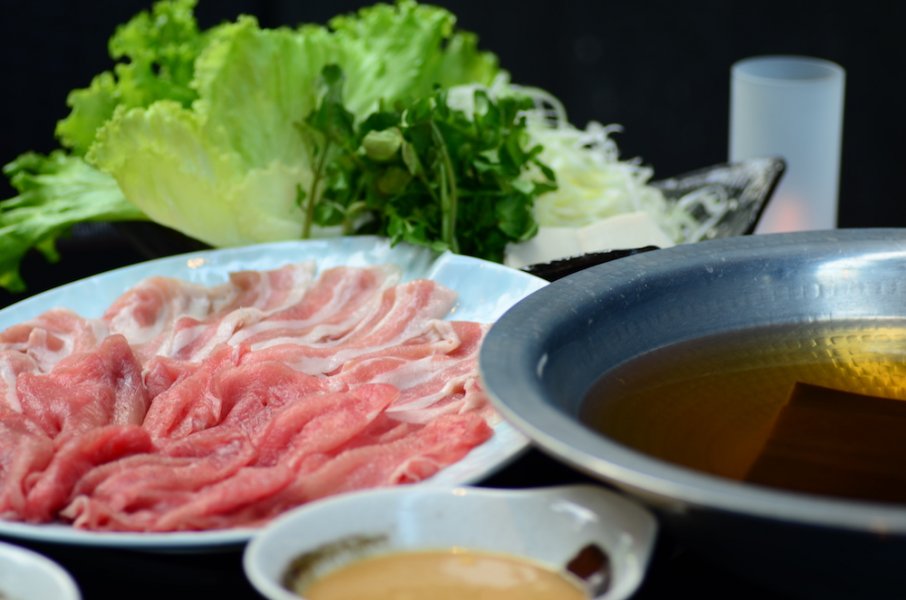
Okinawan cuisine is big on meat, especially pork, and the people of the island are famously said to consume every part of the animal. Agu is a breed of black pig indigenous to the land and due to its beef-like marbling, sweet taste and relatively small numbers, particularly after World War II, it is a prized meat.
Where to try it: Dashi Master Marusaya on Robertson Quay, famous for its nuanced and deep-flavored dashi stock, showcases agu pork in a simple, unadulterated way: slices of the meat are served alongside a hot pot full of stock, shabu shabu-style.
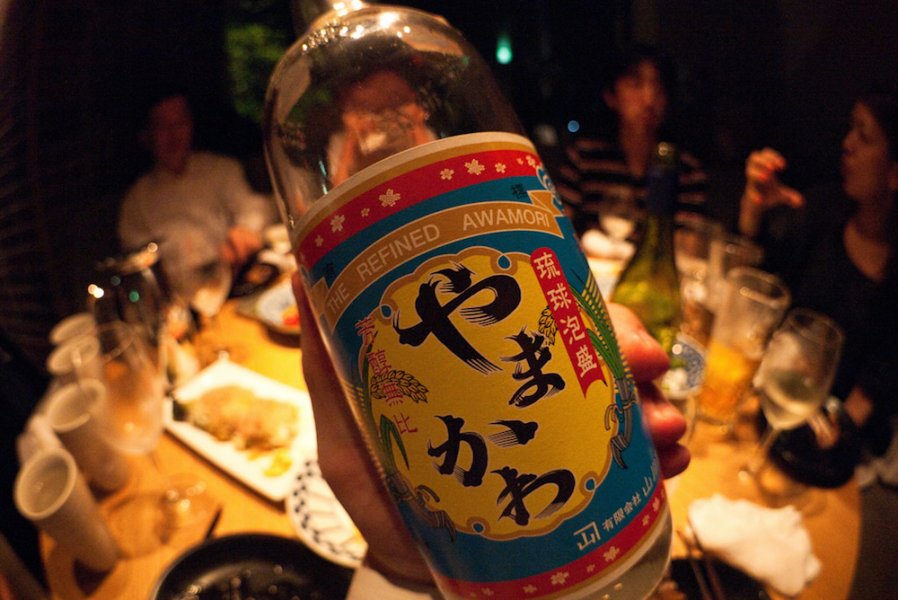
Photo credit flickr user nokton
This distilled spirit is traditionally made from rice grains indigenous to Okinawa—though today it is more likely to be made from Thai rice. Awamori is a more refined cousin of shochu and a popular drink for social gatherings on the island. It is enjoyed on the rocks, or splashed with a bit of water—although awamori cocktails are increasingly common.
Where to try it: The sleek, wood-panelled and perpetually packed izakaya En Japanese Dining Bar has a pretty wide selection of drinks, including several awamori.
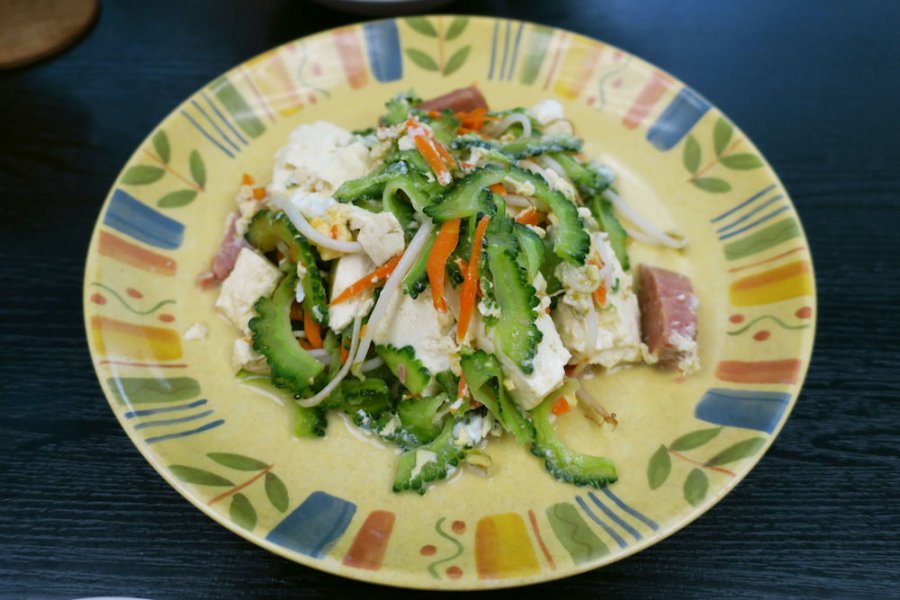
Photo credit flickr user ekkun
No primer on Okinawan cuisine would be complete without this dish. This stir-fry of bitter melon, tofu, pork and eggs is equal parts comforting and delicious. Goya refers to the bitter melon, which is a beloved vegetable on the island, and appears in many other forms, including salads and tempura.
Where to try it: Drinks aside, En Japanese Dining Bar’s menu features many Okinawan dishes, including this one.
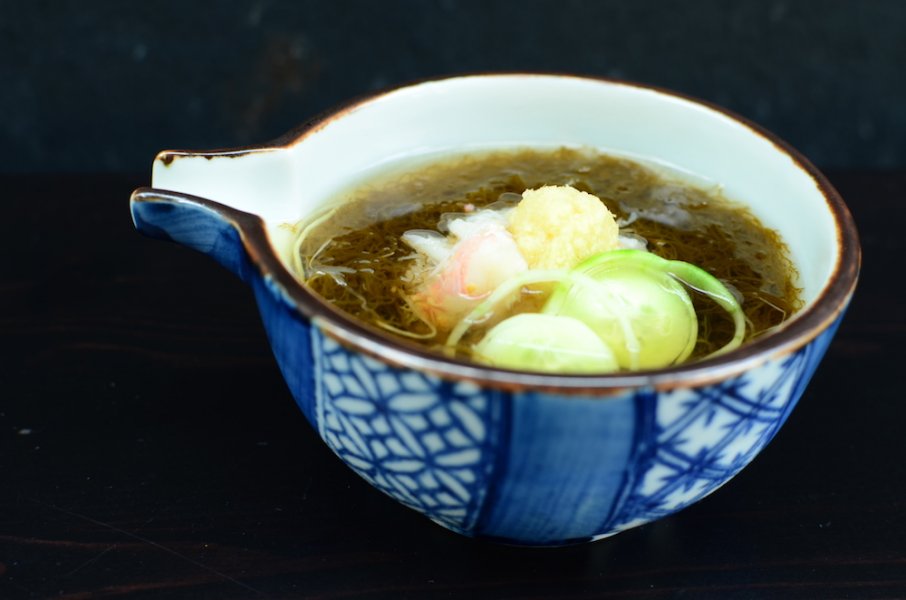
The mozuku seaweed found in the oceans of Okinawa is particularly famous for its thickness, packed nutrition profile, tumor-suppressing properties and low calorie count—making it both extremely healthy and also a great diet food.
Where to try it: Although not technically an Okinawan restaurant, Dashi Master Marusaya appreciates and employs the special properties of certain ingredients from the island. Along with agu pork, chef Eno also serves a light stew, involving her famous dashi, mozuku seaweed, spring onions and other seafood.
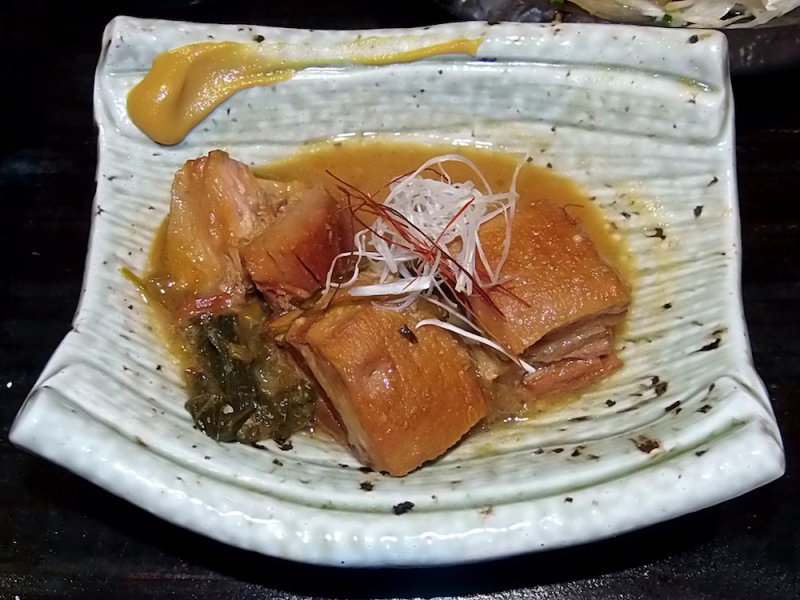
Photo credit flickr user Nemo's great uncle
Inspired by centuries of Chinese trade influence is this dish of long-braised pork belly. The skin is left on, and the pieces of meat are slow-stewed with soya sauce and brown sugar which gives the dish a rich glaze.
Where to get it: Tucked in the basement of Liang Court, already famous for its plethora of Japanese shops, restaurants and supermarket, is the all-Okinawan restaurant Nirai-Kanai (B1-01/02 177 River Valley Rd., 6339-4811). In addition to rafute, they also serve goya champuru and traditional Okinawa soba, among other dishes.
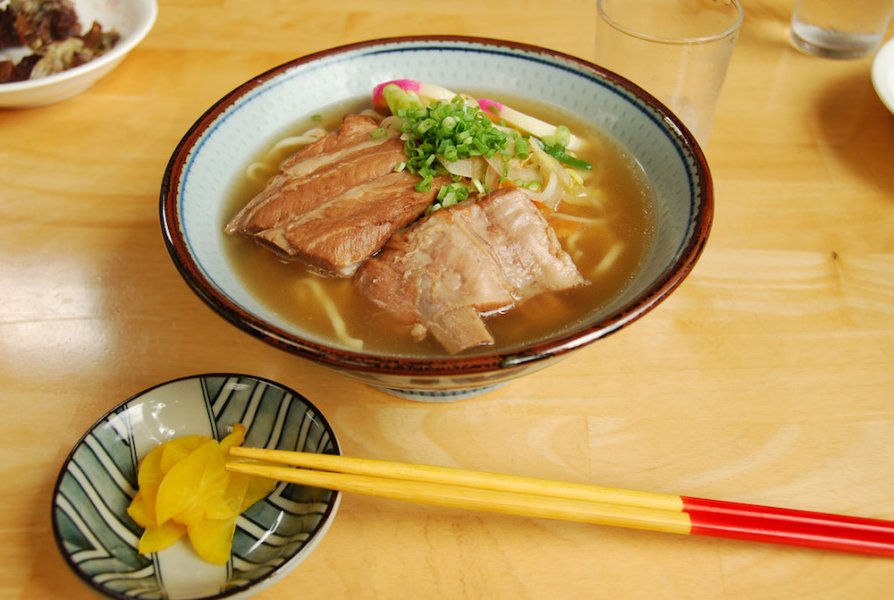
Photo credit flickr user sho(255)
Combining two great Okinawan food obsessions, pork and noodles, soki soba is a light noodle soup involving simmered, fall-off-the-bone pork spare rib, soft soba noodles and additions like tea-pickled eggs, pickles leeks and spring onions. The clear broth is simple, made with kelp, bonito flakes, sake and other flavorings.
Where to try it: It might not have a website or a Facebook page, but what Nirai Kanai does have is pretty much all the iconic dishes of Okinawa, including this one.
Like what you see? For regular updates on Japanese food and drink in Singapore, follow Bite! Japan on Facebook.
Advertisement